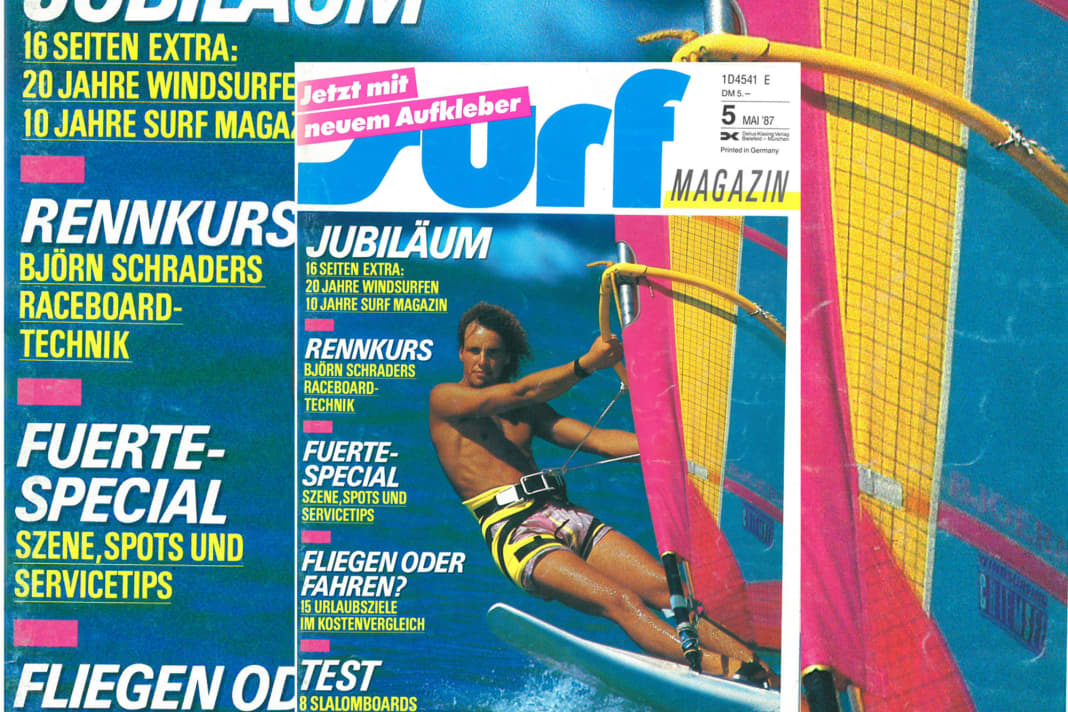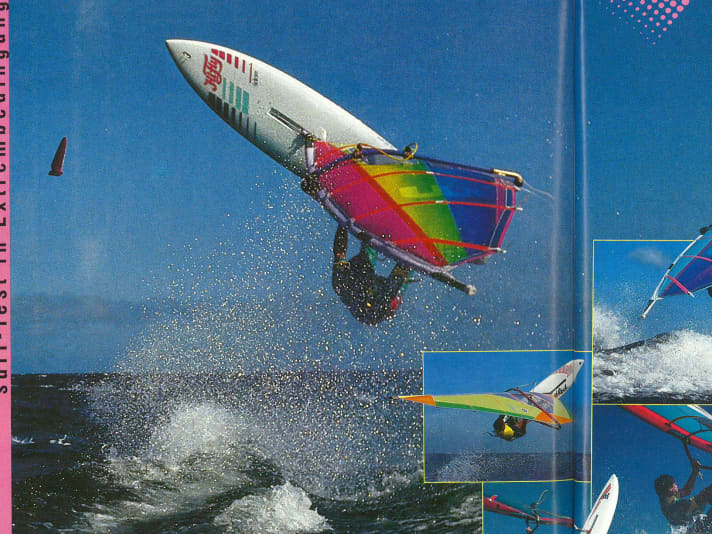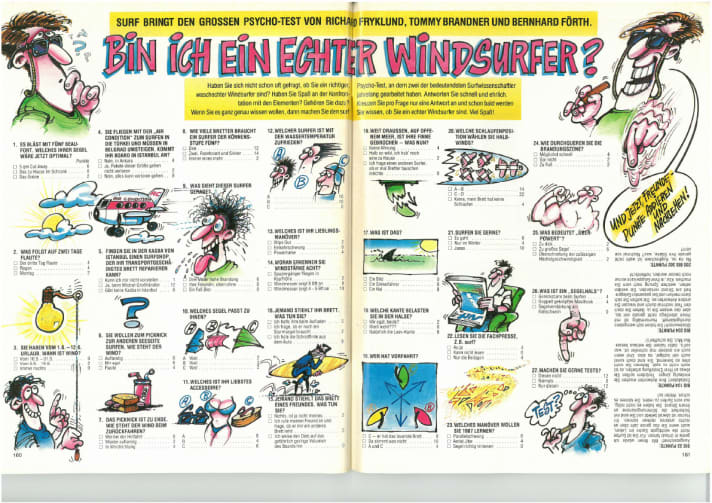





It's a look back within a look back: In spring 1987, surf celebrated its first birthday. At the same time, it was 20 years since Jim Drake had put his invention into the water for the first time. From today's perspective, it is particularly exciting to see how the future of the sport was viewed back then.
Werner and the flying fin
surf test on Gran Canaria, a much-used spot in the 80s. Lots of strong winds made the 1987 slalom test a challenge anyway, and the fact that many of the boards were simply overwhelmed didn't make it any better. The most spectacular picture was provided by Werner Buschmann: He jumped with the HiFly Slalom, his fin a few metres downwind: "It cracked short and dry on the take-off." Albert Pucher became a case for the sea rescuers after breaking his fin, but even with the motorboat, the damaged tester disappeared on the Atlantic. After anxious hours, he resurfaced a few kilometres to the south, having strapped his harness around the tail as an emergency drift inhibitor and allowed himself to be pulled ashore. In total, three fins broke, two fin boxes were bent and one broke completely out of the board.

surf analysed later: The fin boxes - US boxes across the board - are too weak for modern shapes, the fins are getting longer and longer and the riding style more powerful and faster. In extreme conditions, as in the test, fins and boxes reach their limits. The DIN standard in force at the time required the fin to withstand "at least three impacts of defined strength" - in the laboratory test, many models broke on the first impact. The sailboard board underwent a remarkable evolution: From the rapid bending of the first board to a very solid test subject in the impact test - this made surf wonder. All three were sawn through, and lo and behold: the last model had a significantly thicker laminate and an aluminium reinforcement. Suspecting that it could be a board that had been modified for the test, surf advised all buyers to ask the shop to guarantee the reinforcements in writing. In an interview, an expert called for a new fin system, but in view of the costs, gave little hope. But only a short time later, the Powerbox arrived and is still widely used today.
There were no surprises during the test in regular conditions: The F2 Sunset Slalom convinces as a top all-rounder, the Mistral Diamond Head shines with good speed, the HiFly is not quite as fast as the top models, but is easy to control for less experienced riders. However, in addition to the fin problem, breaking base plates, unclean edges, weak gluing and sensitive laminates were also annoying in the test.
20 years of windsurfing, 10 years of surfing
"We wanted writing like Spiegel, a layout like Stern, consumer advice like Stiftung Warentest and cheeky stories like Playboy," say Uli Stanciu and Gerd Kloos, remembering the founding years of surf. In a major article, Jim Drake writes about how he invented windsurfing, what stumbling blocks there were and how he sees the future of the sport. He emphasises one invention in particular: the wind wing - and we all know how this basic idea from back then has since taken off.
Also in the anniversary special: a look back at ten years of Robby Naish. The Peter Brockhaus story is a powerful one: the founder of Mistral and later F2 is a powerful man and reports on how he almost single-handedly shaped the windsurfing market. Although many of his projects were very successful, there were always horrendous costs. "Peter Brockhaus sleeps better with two million marks in debt than others with 200,000 marks in credit," a former F2 managing director is quoted as saying. A fascinating piece of windsurfing history - as well as the "strangest ideas in the surf industry": in addition to curious booms and boards with keels, an inflatable board is also mentioned here. Modern iSUPs can only smile wearily.
Brutal conditions at the World Cup in Omaezaki
Brutal conditions challenge the riders at the World Cup in Japan: a day with nine-strong winds and mast-high waves pushes everyone to their limits. Björn Dunkerbeck manages to finish a race even with a broken fin, but even he has little control. Buoys fly off, regatta boats have to turn away for safety reasons. "The most difficult question of all was the size of the sail: more than three, three, less than three square metres?" In the end - of course - Robby Naish wins, but the boys catch up.
Psycho test: Am I a real windsurfer?
A gem at the end of the magazine: The naturally highly serious test by Richard Fryklund, Tommy Brandner and Bernhard Förth

You can click through the entire magazine in the gallery above!
And what else?
- Jenna de Rosnay gives private lessons on a private island in the Lesser Antilles. Luxury villas are available as accommodation, with Prince Charles and Mick Jagger living next door (at the time)
- The VEB Schichtpresswerk Bernau presents the "Heifan 325", the latest surfboard from the GDR. The equipment includes a mast rail, foot straps and a retractable daggerboard, the sail is fully battened. Nothing is known about the material, but the weight is around 17 kilos
- "I'm sick of always having to win," says a somewhat demotivated Robby Naish before the start of the World Cup season. But later that year, Naish became world champion for the fifth time in a row, after which a certain Björn Dunkerbeck took over the tedious task of winning
- surf shows the best riding technique on the raceboard, with tips on the now almost forgotten capsize loops. The bow of his F2 Lightning alone takes up the entire right-hand half of the double-sided cover.
- "Sweat & Brett": surf shows the jumper fashion of the board manufacturers. From plain white to bright patterns in "poison green and gagger yellow", everything is included.
- Surf readers have problems with rigging two-piece masts with different strengths. There is a harder and a softer side, but they twist. The concept quickly disappeared again, but the solution is still good today: simply stack the two halves together
- Great: surf explains the rules of right of way with great pictures by Kent Nilsson
- Pearls from the advert: The sensual Jenna de Rosnay breathes "When technology borders on seduction" - referring to a sleek Tiga board
- "Computer holiday adventure for floppy freaks": The company CompuCamp offers surfing courses in which the theory is taught on the computer
- Safety feature for sinkers: there is an inflatable floating ring for the board, which is otherwise wrapped around the mast, so that you can get back to shore even in calm conditions.
More surf reviews:
- These were the highlights in surf 6/1978
- These were the highlights in surf 4/1979
- These were the highlights in surf 4/1981
- These were the highlights in surf 5/1982
- These were the highlights in surf 9/1984
- These were the highlights in surf 8/1985
- These were the highlights in surf 8/1986
- These were the highlights in surf 8/1988
- These were the highlights in surf 4/1990
- These were the highlights in surf 6/1991
- These were the highlights in surf 3/1992
- These were the highlights in surf 9/1993
- These were the highlights in surf 4/1994
- These were the highlights in surf 11-12/1996
- These were the highlights in surf 7/1997

